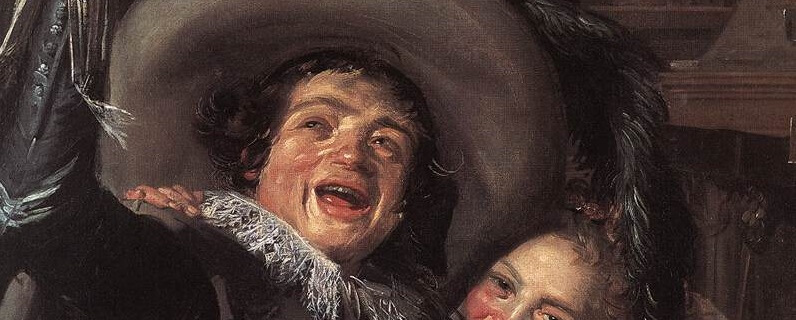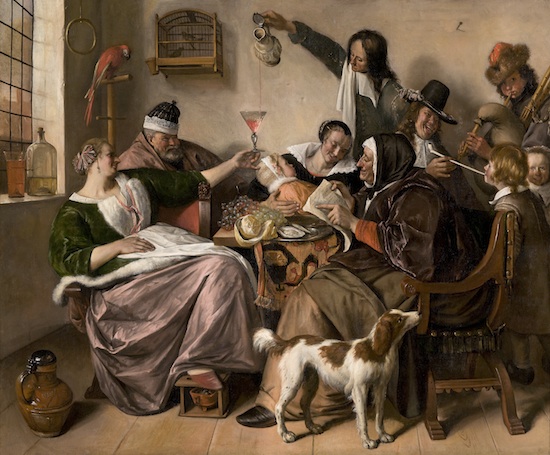An Ode To Dutch Reformed Art

A. I confess that I am no art historian, though I know enough of art and history to make a wager, and it is this: at the time, the “Yonker Ramp” from Frans Hals’ 1623 painting (pictured below) was the happiest man ever committed to color and canvas.

B. Granted, more joyous moments in history and literature had certainly been captured by artists. Mary Magdalene’s garden meeting with the resurrected Christ, for instance. The gladness of the prodigal son’s longsuffering father. However, the joy and gladness of these moments is often intuited by the viewer, not written large on the faces of the painted characters.

Renaissance artists rarely painted the moment of action, but the moment before the action: Christ preparing to step into the Jordan for baptism, the millisecond prior to Mary’s comprehension that Gabriel was in the room with her. A lifelike body attended by appropriately symbolic flora and fauna— this was often enough to satisfy a Renaissance painter. However, the Reformation played an interesting havoc on artistic orthodoxies.
Bar rooms are common to 17th century Dutch art; discerning a finger-wagging moralistic tableau from a foot-stomping good time can be difficult. The Dutch love of drinking seems only matched by the Dutch love of chastising drinkers.

Dutch wealth ran so deep in the 17th century, they could afford not only to drink robustly, but to commission paintings of themselves drinking robustly.

For many years now, I have told my students that if I could live anywhere, and at any time in history, I would live in 17th century Holland. Being Orthodox, I grant this is, perhaps, not the most pious of claims, but it is nonetheless true. My fascination with Holland first emerged after reading Zbigniew Herbert’s “The Price of Art,” an essay about the economics of the Golden Age of Dutch art wherein the Polish poet claims that art was nothing less than currency in 17th century Holland. The man who could paint an apple or a Christ or a Caesar Augustus could, in modern parlance, print his own money. Art was not simply tradeable in 17th Holland, it was liquid money. Dutch men were wild about art; Herbert claims that average Dutch man in the 1600s owned more than 200 pieces of art. Massive baker’s bills, brewer’s bills, and mortgages were settled with paintings. Every kind of painting became allowable. Landscapes and fruit bowls, historical scenes, biblical scenes, kitchen scenes, bedroom scenes. The chasm which separated the holy from the sacred during the Medieval Era collapsed when the Carolingian Renaissance was fulfilled, and more and more men came to live within a stone’s throw of a cathedral. Living near churches made common men rich; that wealth was blown out in the lay want of beauty. In the Medieval Era, all things were inherited and a man only received “a call” to the priesthood or the monastery; when city life bloomed, most men had a say over their labor and fortune, and so every form of work issued from “a call.” The life of an innkeeper was not inherited, but chosen. In the great muddling of sacred and secular, the inn and countryside and bar and bedroom became sanctified for art.
What kind of a culture is so rich as to trade art like cash?
Sadly, a culture which the founders of this nation fled like the plague.
A’. The Yonker Ramp raises his glass to heaven, blessing God and toasting his own good fortune. The couple are either newly engaged, and the young woman has just said, “Yes!” Or, as is suggested by the color in the woman’s cheeks, they are newlyweds, or else the woman has just told her husband she is pregnant. The dog the man caresses with his hand symbolizes fidelity and loyalty, and so the couple are not simply sleeping together, but in a chaste and righteous relationship. The woman stares at the viewer, dazzled by her own good luck to have landed such a man as this. She has not just kissed the Yonker Ramp, but rather confessed something delightful to him, for her mouth is near his ear.
She embraces the man lightly from behind— a posture of familiar, confident, and friendly affection. Her hands are on his shoulders as though she steadies her own body on his. The image is boisterous; both the man and the woman are depicted with open mouths, sighing contentedly or hollering out toasts, and the scene is not confined to a small intimate coterie of friends, but takes place in public, in a restaurant.
The joy of the couple is a personal joy, a manifest joy— it is not intuited, or carefully discerned. The Ramp’s joy and his face are not separable. The joy overflows from his smile, his eyes. He does not speak, he bellows. “Hey!” he shouts, spontaneously lifting the glass.
While no artist is obligated to personalize the emotions of his characters in their countenances (realism was born passé), the Yonker Ramp invites us into an intimately joyful moment on his own terms. It is hard to turn him down.

Joshua Gibbs
Joshua Gibbs teaches online classes at GibbsClassical.com. He is the author of How To Be Unlucky, Something They Will Not Forget, and Blasphemers. His wife is generous and his children are funny.










